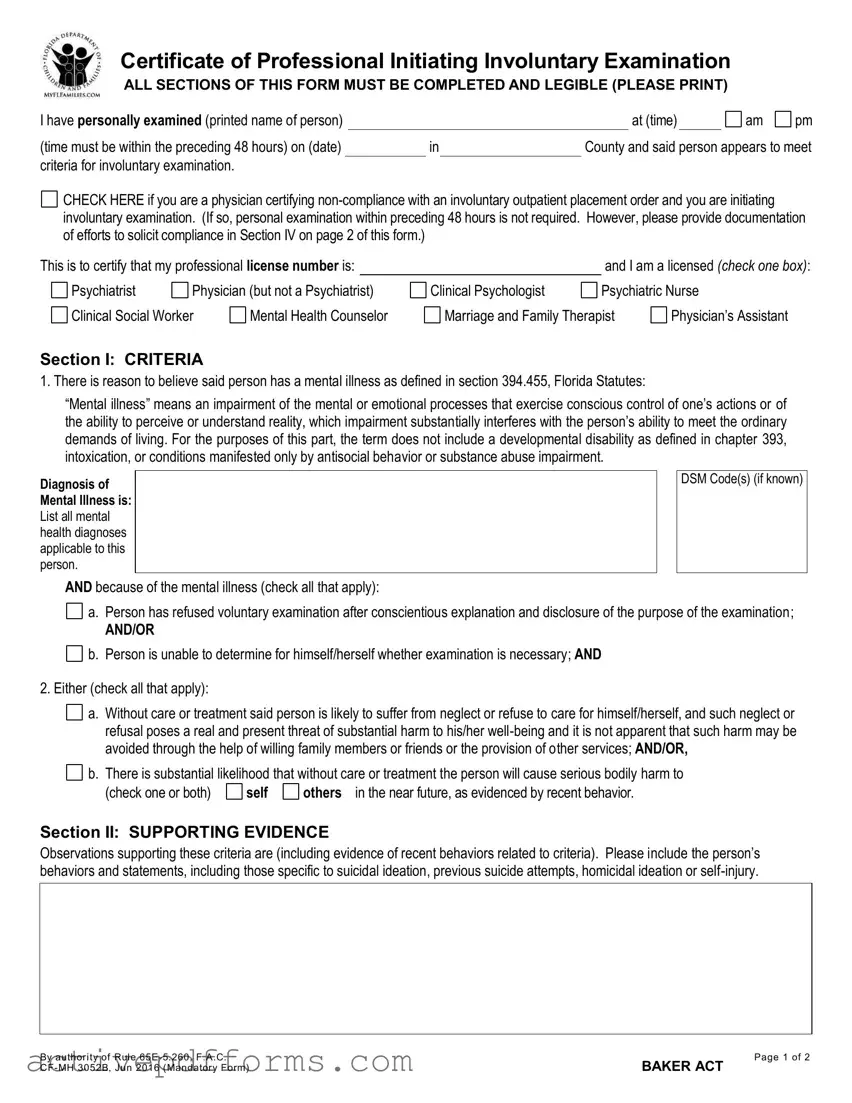Certificate of Professional Initiating Involuntary Examination
ALL SECTIONS OF THIS FORM MUST BE COMPLETED AND LEGIBLE (PLEASE PRINT)
I have personally examined (printed name of person) |
|
|
|
|
at (time) |
|
am |
pm |
(time must be within the preceding 48 hours) on (date) |
|
|
in |
|
County and said person appears to meet |
criteria for involuntary examination. |
|
|
|
|
|
|
|
|
CHECK HERE if you are a physician certifying non-compliance with an involuntary outpatient placement order and you are initiating involuntary examination. (If so, personal examination within preceding 48 hours is not required. However, please provide documentation of efforts to solicit compliance in Section IV on page 2 of this form.)
This is to certify that my professional license number is:
|
|
|
|
|
Psychiatrist |
|
Physician (but not a Psychiatrist) |
Clinical Social Worker |
|
Mental Health Counselor |
|
|
|
|
|
and I am a licensed (CHECK ONE BOX): |
Clinical Psychologist |
Psychiatric Nurse |
Marriage and Family Therapist |
Physician’s Assistant |
Section I: CRITERIA
1. There is reason to believe said person has a mental illness as defined in section 394.455, Florida Statutes:
“Mental illness” means an impairment of the mental or emotional processes that exercise conscious control of one’s actions or of the ability to perceive or understand reality, which impairment substantially interferes with the person’s ability to meet the ordinary
demands of living. For the purposes of this part, the term does not include a developmental disability as defined in chapter 393, intoxication, or conditions manifested only by antisocial behavior or substance abuse impairment.
Diagnosis of Mental Illness is: List all mental health diagnoses applicable to this person.
AND because of the mental illness (check all that apply):
a. Person has refused voluntary examination after conscientious explanation and disclosure of the purpose of the examination;
AND/OR
b. Person is unable to determine for himself/herself whether examination is necessary; AND
2. Either (check all that apply):
a. Without care or treatment said person is likely to suffer from neglect or refuse to care for himself/herself, and such neglect or refusal poses a real and present threat of substantial harm to his/her well-being and it is not apparent that such harm may be avoided through the help of willing family members or friends or the provision of other services; AND/OR,
b. There is substantial likelihood that without care or treatment the person will cause serious bodily harm to
(check one or both) |
|
self |
|
others in the near future, as evidenced by recent behavior. |
Section II: SUPPORTING EVIDENCE
Observations supporting these criteria are (including evidence of recent behaviors related to criteria). Please include the person’s behaviors and statements, including those specific to suicidal ideation, previous suicide attempts, homicidal ideation or self-injury.
By authority of Rule 65E-5.260, F.A.C. |
Page 1 of 2 |
CF-MH 3052B, Jun 2016 (Mandatory Form) |
BAKER ACT |

Certificate of Professional Initiating Involuntary Examination
Section III: OTHER INFORMATION
Other information, including source relied upon to reach this conclusion is as follows. If information is obtained from other persons, describe these sources (e.g., reports of family, friends, other mental health professionals or law enforcement officers, as well as medical or mental health records, etc.).
Section IV: NON-COMPLIANCE WITH INVOLUNTARY OUTPATIENT PLACEMENT ORDER
Complete this section if you are a physician who is documenting non-compliance with an involuntary outpatient placement order: This is to certify that I am a physician, as defined in Florida Statutes 394.455, F.S. and in my clinical judgment, the person has failed or has refused to comply with the treatment ordered by the court, and the following efforts have been made to solicit compliance with the treatment plan:
Section V: INFORMATION FOR LAW ENFORCEMENT
Provide identifying information (if known) if requested by law enforcement to find the person so he/she may be taken into custody for examination:
Other details (such as height, weight, hair color, what wearing when last seen, where last seen):
If relevant, information such as access to weapon, recent violence or pending criminal charges:
This form must be transported with the person to the receiving facility to be retained in the clinical record. Copies may be retained by the initiating professional and by the law enforcement agency transporting the person to the receiving facility.
Section VI: SIGNATURE
am
Signature of Professional |
Date Signed |
Time |
Printed Name of Professional |
Phone Number (including area code)) |
By authority of Rule 65E-5.260, F.A.C. |
Page 2 of 2 |
CF-MH 3052B, Jun 2016 (Mandatory Form) |
BAKER ACT |


